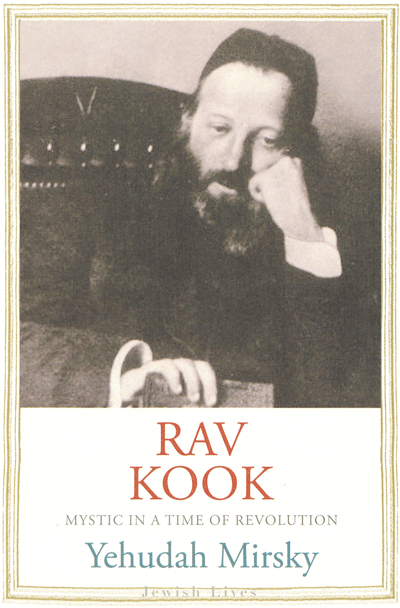Rav Kook: Mystic in a Time of Revolution, by Yehudah Mirsky, Yale, 273 pages, $25
Reviewed by NEAL GENDLER
Like Mozart, Rabbi Abraham Isaac Kook enjoys far wider esteem now than during his life.
“Rav Kook is today best known in the West — if at all — as the founding chief rabbi of modern Israel and the spiritual godfather of religious Zionism,” says Yehudah Mirsky, whose Rav Kook is intended as “a brief, accessible presentation” of Kook’s life, teachings and legacy.

“Souls of his magnitude do not come our way often,” says Mirsky, associate professor in Near Eastern and Judaic studies at Brandeis University. “His controversial life and the colossal body of writing he left behind offer powerful lessons and pose difficult questions. The contradictions of his life and thought are in many ways the defining contradictions of modern Jewish history.”
So who was Kook?
Kook was a phenomenon who lived from 1865 to 1935, a Lithuanian-born rabbinic prodigy whose Torah-scholar education included time at the prestigious Volozhin yeshiva. He became familiar with Eastern Europe’s Jewish movements, including Hassidism, Kabbala and Zionism. Even as a young rabbi, he wrote and published, eventually leading a congregation in a city near Riga with the charmingly Old World name of Boisk (modern Bauska).
Between 1901 and 1904, he published a series of essays showing support for Jewish nationalism, but “he contended that Zionism could not hope to succeed if it remained divorced from religion,” Mirsky says.
Moving to Jaffa in 1904, at the start of the second aliya, he saw redemptive value in the non-observant pioneers who, he wrote, were building the land with “joie de vivre, mental expansion and national pride.” The old-style rabbis with “stooped backs… wrinkled sad faces sowing fear and downheartedness” and “strange Eastern garb,” considered the pioneers sinners.
Discounting Kook’s punctilious observance and tzadik-like demeanor, they vilified him to the end of his life and beyond. Their followers, too: Agudat Yisroel youth “at times threw buckets of water in his face as he walked down the street.”
Kook’s vision for a new kind of yeshiva, with secular topics and instruction in Hebrew, grew into Mercaz HaRav, decades later graduating founders of Gush Emunim settlements.
Kook wrote prolifically, seeking to clarify his thinking, sometimes applying kabbalistic interpretations to the realities of Israeli pioneer life. Mirsky makes a valiant effort to sample those notebooks in layman’s English, but sometimes the excerpts’ complexity, mysticism and subtlety left me wondering what I’d just read.
The book, in Yale University’s “Jewish Lives” series, is more demanding than those about Sarah Bernhardt, Hank Greenberg and Moshe Dayan. That’s understandable. Those follow people’s actions, while Kook’s story is largely one of ideas.
Mirsky says Kook despaired of adequately expressing himself, and even some contemporaries who admired his brilliance pointed out views that were contradictory.
But Kook’s self-appointed task was difficult: attempting to reconcile Jewish law and tradition with new realities. Mirsky says Kook laid a “theological foundation for marrying Torah study to Zionism, and for an ethos of traditional Judaism engaged with Zionism and with modernity.”
Mirsky slows readers by too freely using words that, while precise, send many of us to dictionaries. Examples: theodicy, mendicant, encomium, telos, protean, pellucid, deracinated, etymological, epistemological and ontologically. After seeing theurgic, mimesis and simulacrum in a single sentence on page 113, I stopped keeping track.
Accessibility — and maybe sales — might have been enhanced by following the advice of my first newspaper editor: “Never use a 50-cent word when a nickel word will do.” And the publisher should have diminished Mirsky’s use of “dialectic” in its many variations so there’d be some left for another author.
Today, Mirsky says, there is a “vast and growing body of literature on [Kook] in Hebrew,” but a dearth in English. Mirsky calls Rav Kook “an attempt to create a fellowship of readers from disparate communities… a book about a man who tried to do the same on a vastly more consequential scale.”
***
Neal Gendler is a Minneapolis writer and editor.
(American Jewish World, 3.28.14)



















